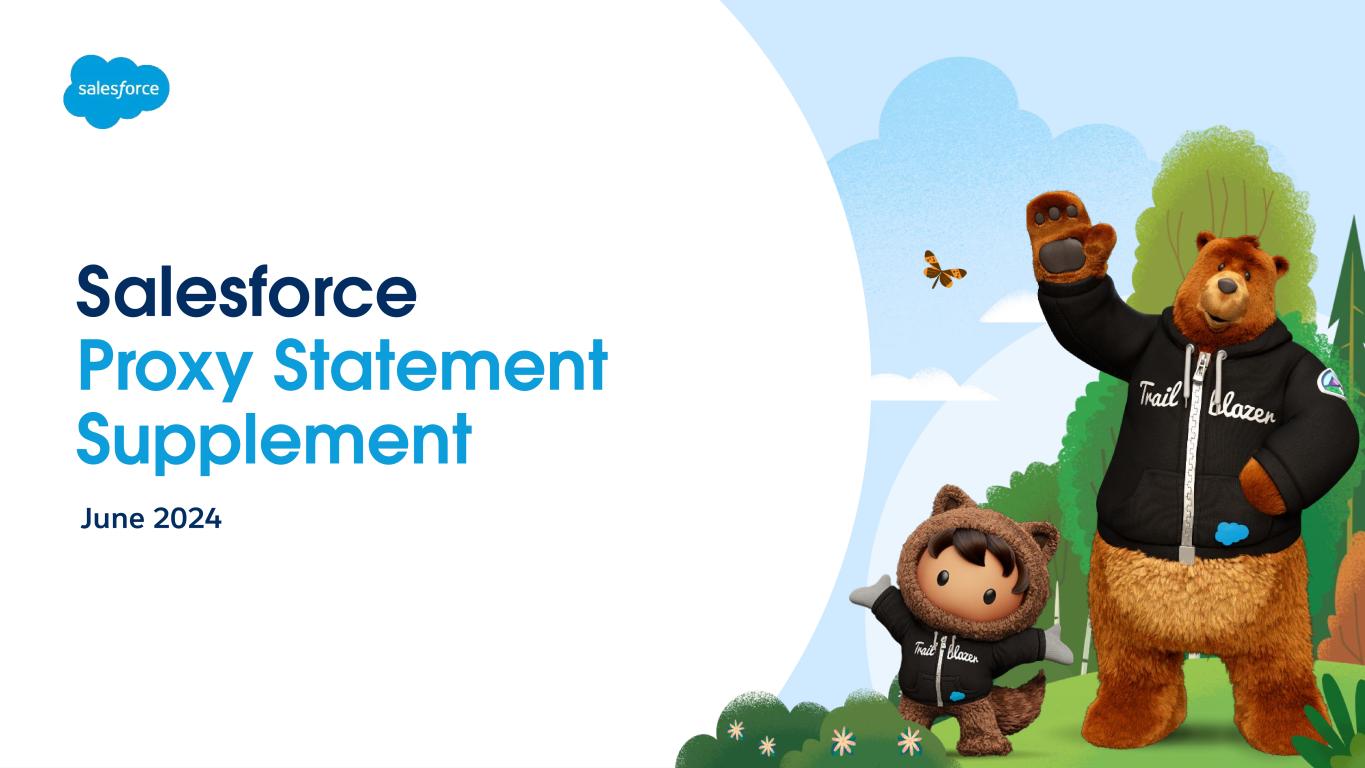
Salesforce Proxy Statement Supplement 1 June 2024
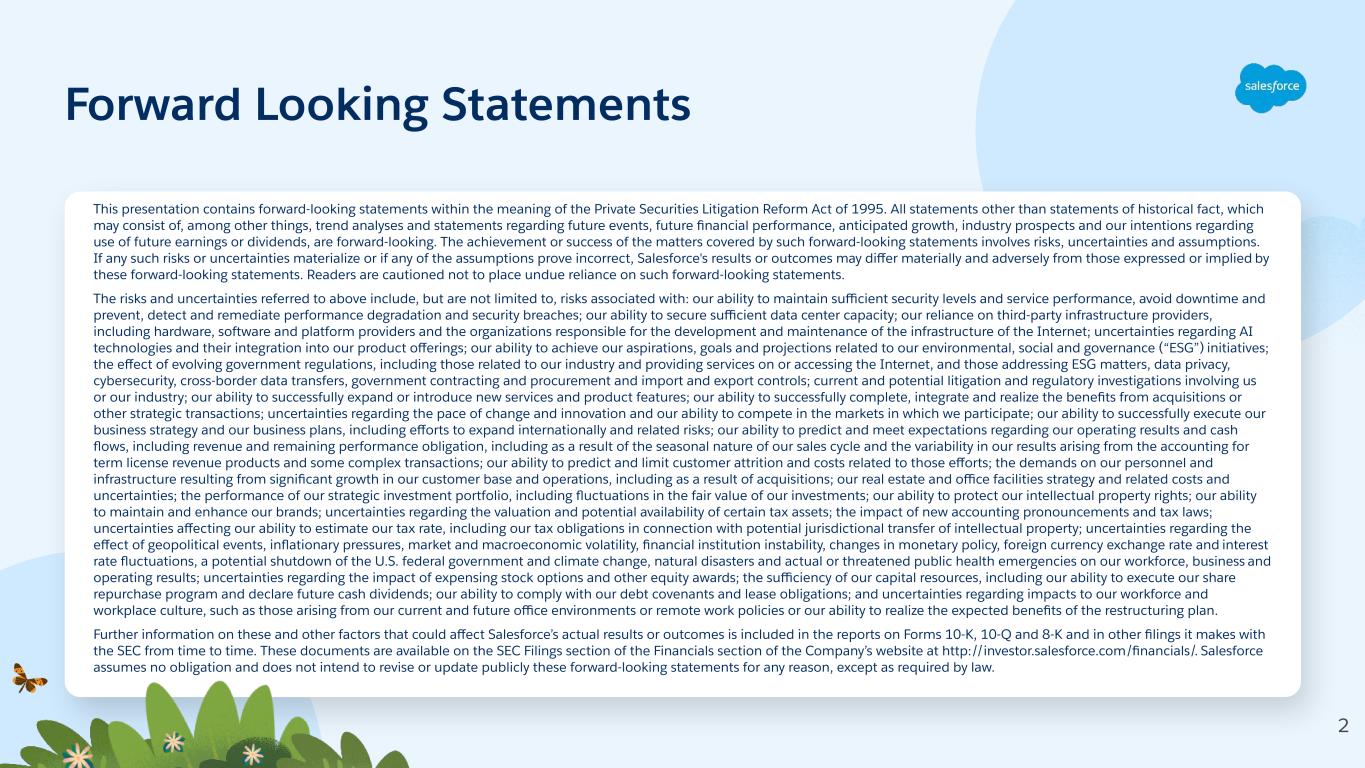
This presentation contains forward-looking statements within the meaning of the Private Securities Litigation Reform Act of 1995. All statements other than statements of historical fact, which may consist of, among other things, trend analyses and statements regarding future events, future financial performance, anticipated growth, industry prospects and our intentions regarding use of future earnings or dividends, are forward-looking. The achievement or success of the matters covered by such forward-looking statements involves risks, uncertainties and assumptions. If any such risks or uncertainties materialize or if any of the assumptions prove incorrect, Salesforce's results or outcomes may differ materially and adversely from those expressed or implied by these forward-looking statements. Readers are cautioned not to place undue reliance on such forward-looking statements. The risks and uncertainties referred to above include, but are not limited to, risks associated with: our ability to maintain sufficient security levels and service performance, avoid downtime and prevent, detect and remediate performance degradation and security breaches; our ability to secure sufficient data center capacity; our reliance on third-party infrastructure providers, including hardware, software and platform providers and the organizations responsible for the development and maintenance of the infrastructure of the Internet; uncertainties regarding AI technologies and their integration into our product offerings; our ability to achieve our aspirations, goals and projections related to our environmental, social and governance (“ESG”) initiatives; the effect of evolving government regulations, including those related to our industry and providing services on or accessing the Internet, and those addressing ESG matters, data privacy, cybersecurity, cross-border data transfers, government contracting and procurement and import and export controls; current and potential litigation and regulatory investigations involving us or our industry; our ability to successfully expand or introduce new services and product features; our ability to successfully complete, integrate and realize the benefits from acquisitions or other strategic transactions; uncertainties regarding the pace of change and innovation and our ability to compete in the markets in which we participate; our ability to successfully execute our business strategy and our business plans, including efforts to expand internationally and related risks; our ability to predict and meet expectations regarding our operating results and cash flows, including revenue and remaining performance obligation, including as a result of the seasonal nature of our sales cycle and the variability in our results arising from the accounting for term license revenue products and some complex transactions; our ability to predict and limit customer attrition and costs related to those efforts; the demands on our personnel and infrastructure resulting from significant growth in our customer base and operations, including as a result of acquisitions; our real estate and office facilities strategy and related costs and uncertainties; the performance of our strategic investment portfolio, including fluctuations in the fair value of our investments; our ability to protect our intellectual property rights; our ability to maintain and enhance our brands; uncertainties regarding the valuation and potential availability of certain tax assets; the impact of new accounting pronouncements and tax laws; uncertainties affecting our ability to estimate our tax rate, including our tax obligations in connection with potential jurisdictional transfer of intellectual property; uncertainties regarding the effect of geopolitical events, inflationary pressures, market and macroeconomic volatility, financial institution instability, changes in monetary policy, foreign currency exchange rate and interest rate fluctuations, a potential shutdown of the U.S. federal government and climate change, natural disasters and actual or threatened public health emergencies on our workforce, business and operating results; uncertainties regarding the impact of expensing stock options and other equity awards; the sufficiency of our capital resources, including our ability to execute our share repurchase program and declare future cash dividends; our ability to comply with our debt covenants and lease obligations; and uncertainties regarding impacts to our workforce and workplace culture, such as those arising from our current and future office environments or remote work policies or our ability to realize the expected benefits of the restructuring plan. Further information on these and other factors that could affect Salesforce’s actual results or outcomes is included in the reports on Forms 10-K, 10-Q and 8-K and in other filings it makes with the SEC from time to time. These documents are available on the SEC Filings section of the Financials section of the Company’s website at http://investor.salesforce.com/financials/. Salesforce assumes no obligation and does not intend to revise or update publicly these forward-looking statements for any reason, except as required by law. Forward Looking Statements 2
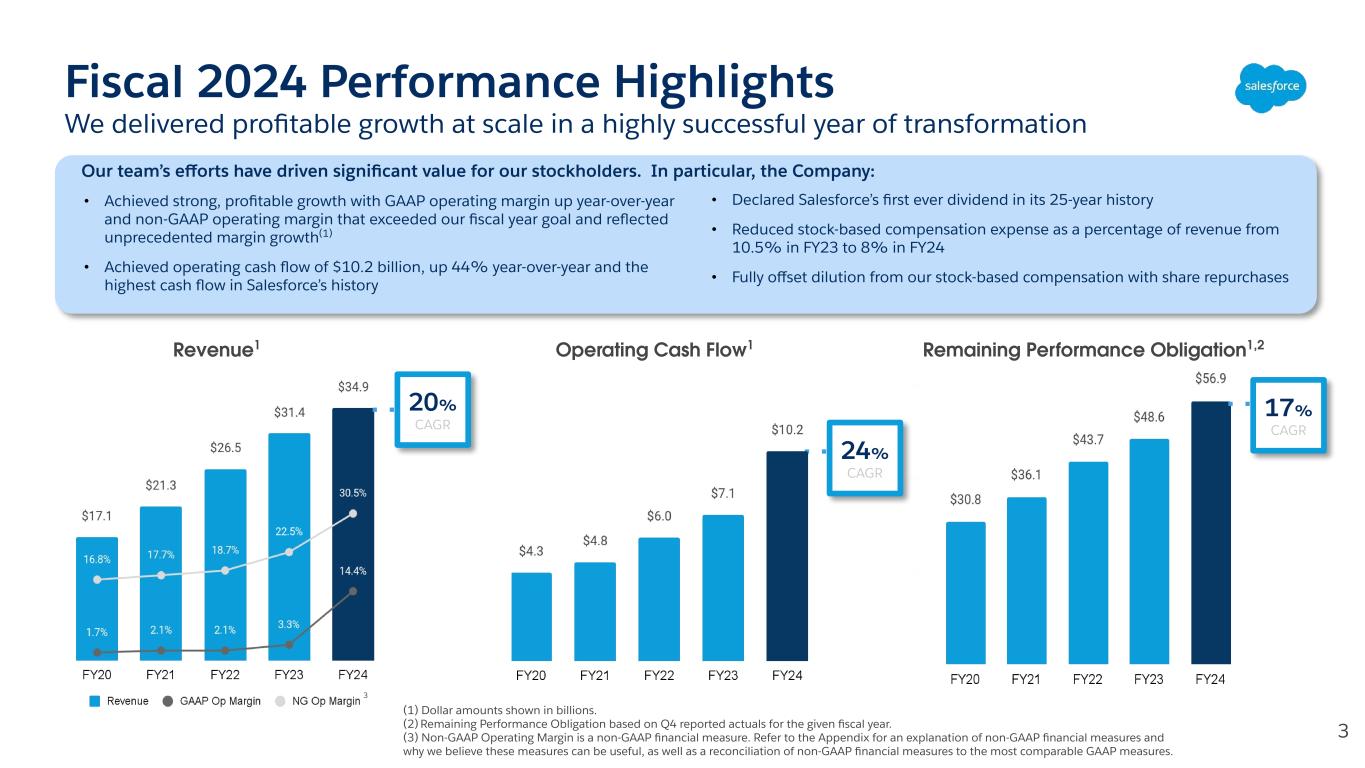
Revenue 2 Operating Cash Flow 2 Remaining Performance Obligation 3 17% CAGR 24% CAGR 3 20% CAGR Fiscal 2024 Performance Highlights We delivered profitable growth at scale in a highly successful year of transformation Our team’s efforts have driven significant value for our stockholders. In particular, the Company: • Achieved strong, profitable growth with GAAP operating margin up year-over-year and non-GAAP operating margin that exceeded our fiscal year goal and reflected unprecedented margin growth(1) • Achieved operating cash flow of $10.2 billion, up 44% year-over-year and the highest cash flow in Salesforce’s history Operating Cash Flow1 Remaining Performance Obligation1,2Revenue1 (1) Dollar amounts shown in billions. (2) Remaining Performance Obligation based on Q4 reported actuals for the given fiscal year. (3) Non-GAAP Operating Margin is a non-GAAP financial measure. Refer to the Appendix for an explanation of non-GAAP financial measures and why we believe these measures can be useful, as well as a reconciliation of non-GAAP financial measures to the most comparable GAAP measures. • Declared Salesforce’s first ever dividend in its 25-year history • Reduced stock-based compensation expense as a percentage of revenue from 10.5% in FY23 to 8% in FY24 • Fully offset dilution from our stock-based compensation with share repurchases 3
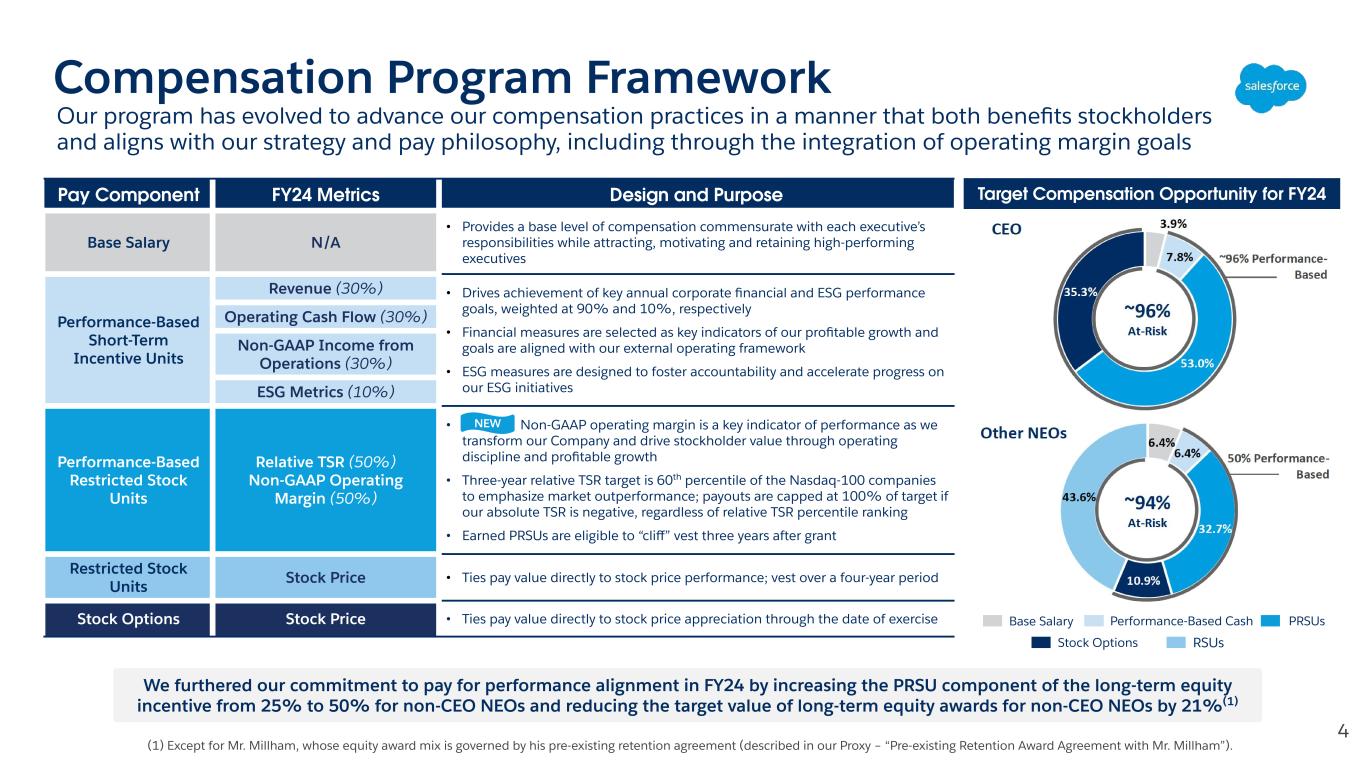
RSUs Our program has evolved to advance our compensation practices in a manner that both benefits stockholders and aligns with our strategy and pay philosophy, including through the integration of operating margin goals 4 Pay Component FY24 Metrics Design and Purpose Base Salary N/A • Provides a base level of compensation commensurate with each executive’s responsibilities while attracting, motivating and retaining high-performing executives Performance-Based Short-Term Incentive Units Revenue (30%) • Drives achievement of key annual corporate financial and ESG performance goals, weighted at 90% and 10%, respectively • Financial measures are selected as key indicators of our profitable growth and goals are aligned with our external operating framework • ESG measures are designed to foster accountability and accelerate progress on our ESG initiatives Operating Cash Flow (30%) Non-GAAP Income from Operations (30%) ESG Metrics (10%) Performance-Based Restricted Stock Units Relative TSR (50%) Non-GAAP Operating Margin (50%) • Non-GAAP operating margin is a key indicator of performance as we transform our Company and drive stockholder value through operating discipline and profitable growth • Three-year relative TSR target is 60th percentile of the Nasdaq-100 companies to emphasize market outperformance; payouts are capped at 100% of target if our absolute TSR is negative, regardless of relative TSR percentile ranking • Earned PRSUs are eligible to “cliff” vest three years after grant Restricted Stock Units Stock Price • Ties pay value directly to stock price performance; vest over a four-year period Stock Options Stock Price • Ties pay value directly to stock price appreciation through the date of exercise (1) Except for Mr. Millham, whose equity award mix is governed by his pre-existing retention agreement (described in our Proxy – “Pre-existing Retention Award Agreement with Mr. Millham”). Compensation Program Framework Base Salary Performance-Based Cash PRSUs Stock Options NEW We furthered our commitment to pay for performance alignment in FY24 by increasing the PRSU component of the long-term equity incentive from 25% to 50% for non-CEO NEOs and reducing the target value of long-term equity awards for non-CEO NEOs by 21%(1) Target Compensation Opportunity for FY24
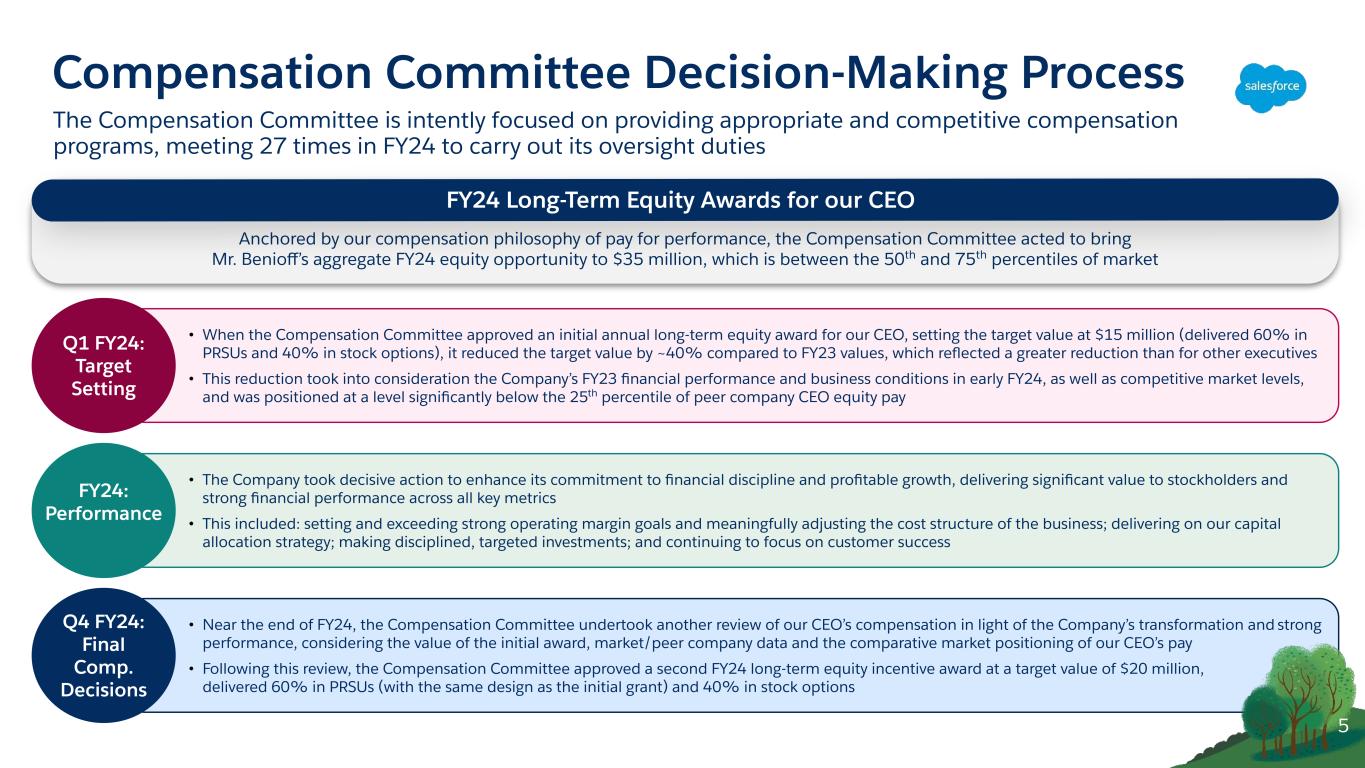
The Compensation Committee is intently focused on providing appropriate and competitive compensation programs, meeting 27 times in FY24 to carry out its oversight duties • Near the end of FY24, the Compensation Committee undertook another review of our CEO’s compensation in light of the Company’s transformation and strong performance, considering the value of the initial award, market/peer company data and the comparative market positioning of our CEO’s pay • Following this review, the Compensation Committee approved a second FY24 long-term equity incentive award at a target value of $20 million, delivered 60% in PRSUs (with the same design as the initial grant) and 40% in stock options • The Company took decisive action to enhance its commitment to financial discipline and profitable growth, delivering significant value to stockholders and strong financial performance across all key metrics • This included: setting and exceeding strong operating margin goals and meaningfully adjusting the cost structure of the business; delivering on our capital allocation strategy; making disciplined, targeted investments; and continuing to focus on customer success • When the Compensation Committee approved an initial annual long-term equity award for our CEO, setting the target value at $15 million (delivered 60% in PRSUs and 40% in stock options), it reduced the target value by ~40% compared to FY23 values, which reflected a greater reduction than for other executives • This reduction took into consideration the Company’s FY23 financial performance and business conditions in early FY24, as well as competitive market levels, and was positioned at a level significantly below the 25th percentile of peer company CEO equity pay Q1 FY24: Target Setting Q4 FY24: Final Comp. Decisions 5 FY24: Performance Compensation Committee Decision-Making Process Anchored by our compensation philosophy of pay for performance, the Compensation Committee acted to bring Mr. Benioff’s aggregate FY24 equity opportunity to $35 million, which is between the 50th and 75th percentiles of market FY24 Long-Term Equity Awards for our CEO
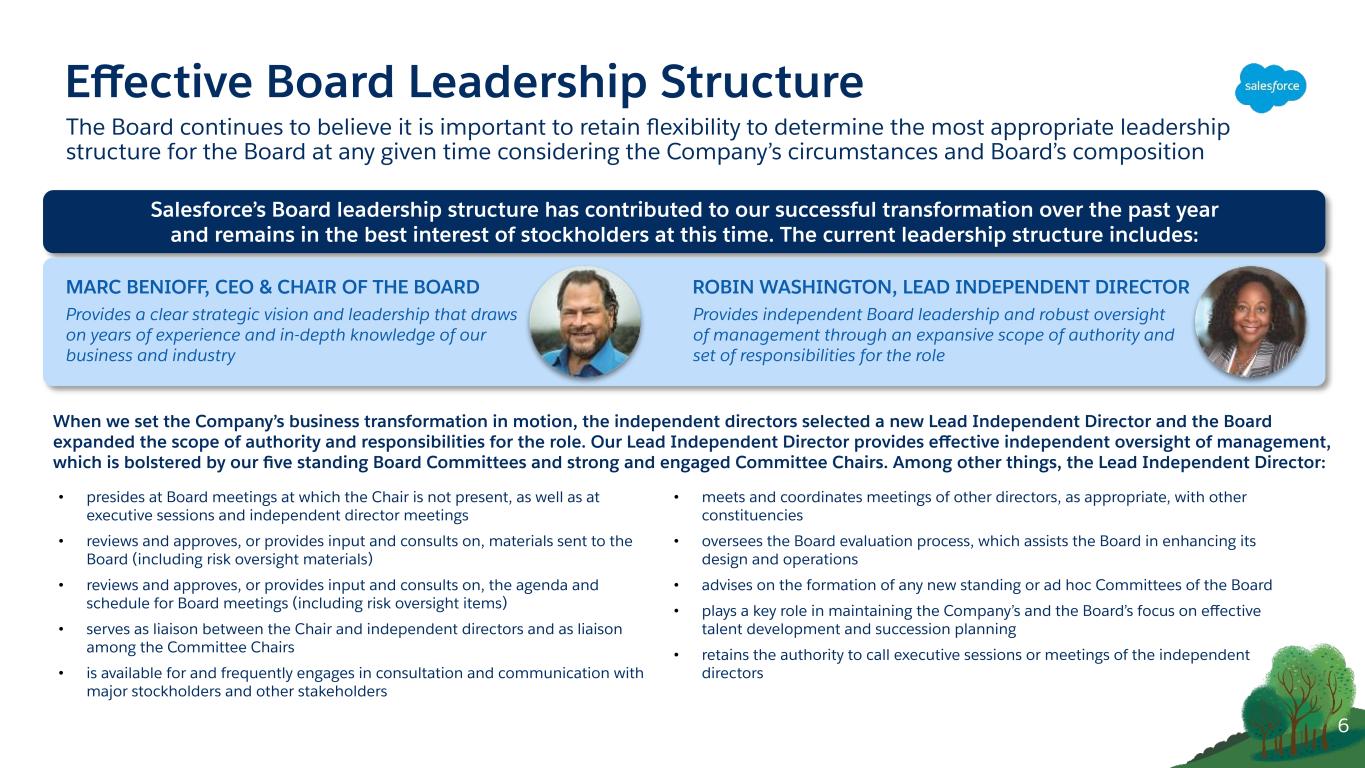
The Board continues to believe it is important to retain flexibility to determine the most appropriate leadership structure for the Board at any given time considering the Company’s circumstances and Board’s composition Effective Board Leadership Structure 6 Salesforce’s Board leadership structure has contributed to our successful transformation over the past year and remains in the best interest of stockholders at this time. The current leadership structure includes: Provides a clear strategic vision and leadership that draws on years of experience and in-depth knowledge of our business and industry MARC BENIOFF, CEO & CHAIR OF THE BOARD ROBIN WASHINGTON, LEAD INDEPENDENT DIRECTOR Provides independent Board leadership and robust oversight of management through an expansive scope of authority and set of responsibilities for the role When we set the Company’s business transformation in motion, the independent directors selected a new Lead Independent Director and the Board expanded the scope of authority and responsibilities for the role. Our Lead Independent Director provides effective independent oversight of management, which is bolstered by our five standing Board Committees and strong and engaged Committee Chairs. Among other things, the Lead Independent Director: • presides at Board meetings at which the Chair is not present, as well as at executive sessions and independent director meetings • reviews and approves, or provides input and consults on, materials sent to the Board (including risk oversight materials) • reviews and approves, or provides input and consults on, the agenda and schedule for Board meetings (including risk oversight items) • serves as liaison between the Chair and independent directors and as liaison among the Committee Chairs • is available for and frequently engages in consultation and communication with major stockholders and other stakeholders • meets and coordinates meetings of other directors, as appropriate, with other constituencies • oversees the Board evaluation process, which assists the Board in enhancing its design and operations • advises on the formation of any new standing or ad hoc Committees of the Board • plays a key role in maintaining the Company’s and the Board’s focus on effective talent development and succession planning • retains the authority to call executive sessions or meetings of the independent directors
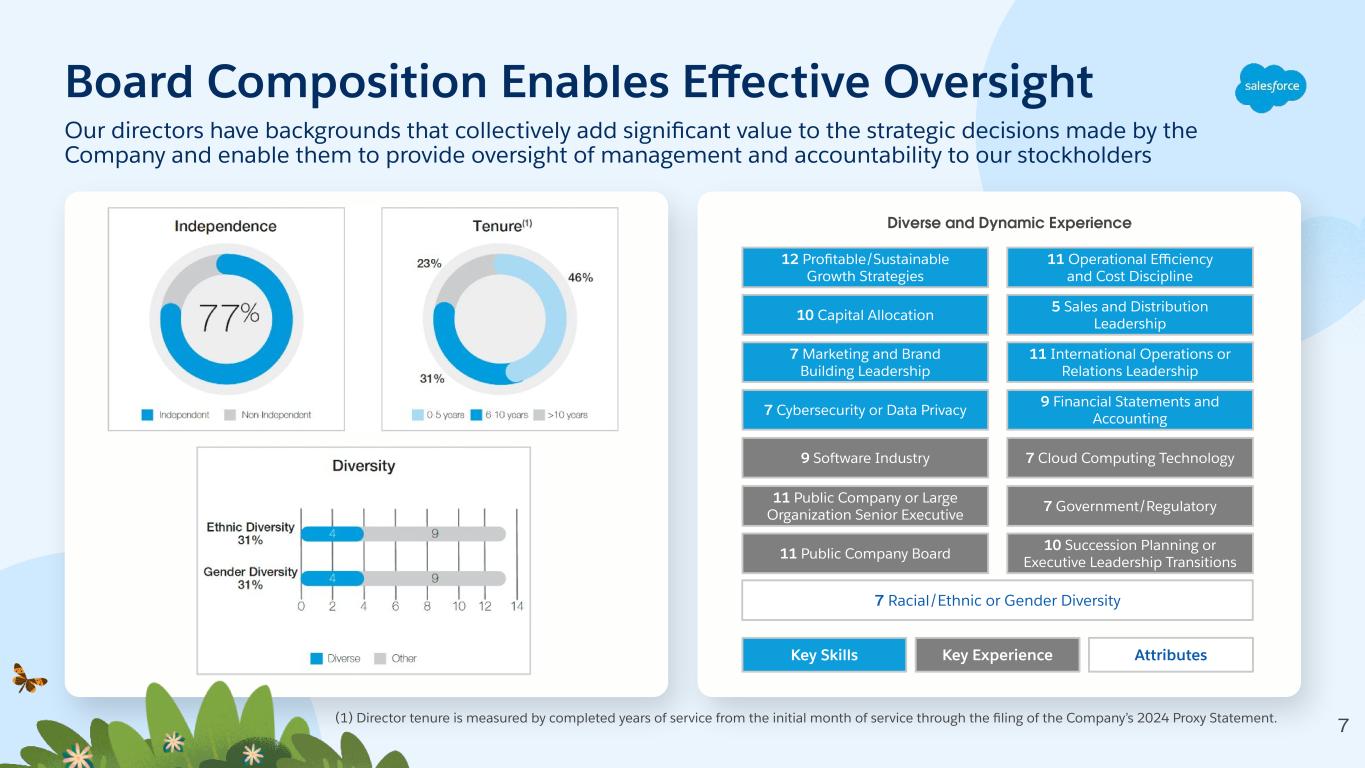
9 Software Industry 7 Cybersecurity or Data Privacy 12 Profitable/Sustainable Growth Strategies 11 Public Company or Large Organization Senior Executive 11 Public Company Board 10 Capital Allocation 7 Marketing and Brand Building Leadership Diverse and Dynamic Experience (1) Director tenure is measured by completed years of service from the initial month of service through the filing of the Company’s 2024 Proxy Statement. 7 Racial/Ethnic or Gender Diversity Key Skills 7 Cloud Computing Technology 9 Financial Statements and Accounting 11 Operational Efficiency and Cost Discipline 7 Government/Regulatory 10 Succession Planning or Executive Leadership Transitions 5 Sales and Distribution Leadership 11 International Operations or Relations Leadership Key Experience Attributes Board Composition Enables Effective Oversight 7 Our directors have backgrounds that collectively add significant value to the strategic decisions made by the Company and enable them to provide oversight of management and accountability to our stockholders
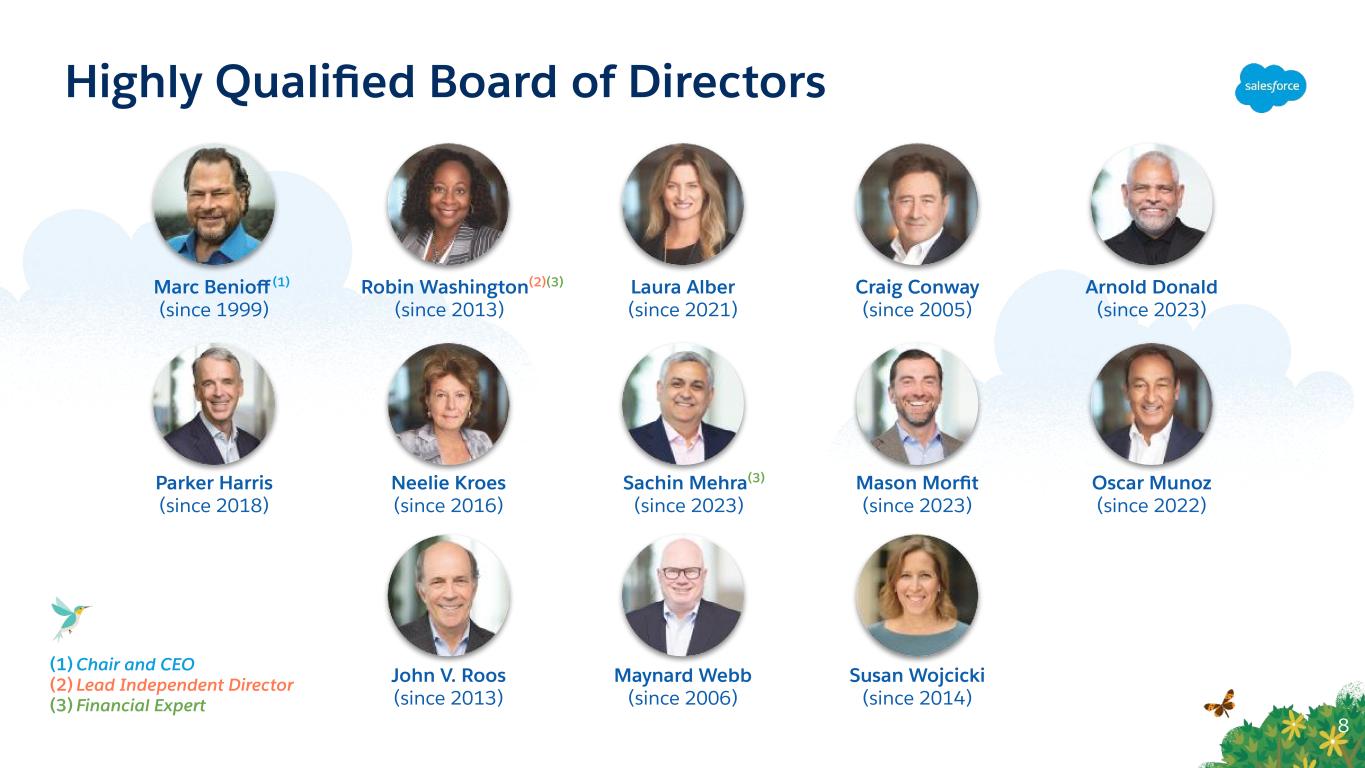
Robin Washington(2)(3) (since 2013) Marc Benioff (1) (since 1999) Oscar Munoz (since 2022) Laura Alber (since 2021) John V. Roos (since 2013) Neelie Kroes (since 2016) Susan Wojcicki (since 2014) Maynard Webb (since 2006) Sachin Mehra(3) (since 2023) Mason Morfit (since 2023) (1) Chair and CEO (2) Lead Independent Director (3) Financial Expert Craig Conway (since 2005) Parker Harris (since 2018) Arnold Donald (since 2023) Highly Qualified Board of Directors 8

Appendix 9
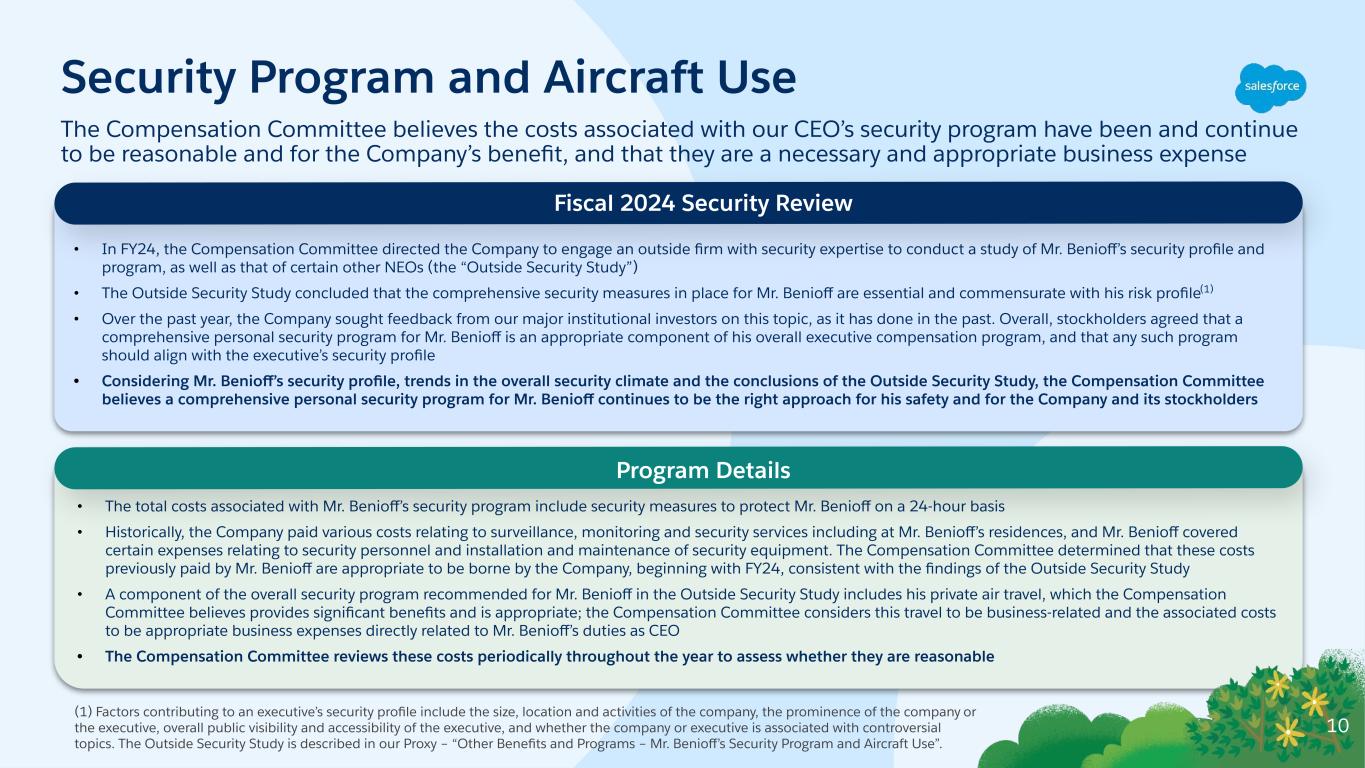
• The total costs associated with Mr. Benioff’s security program include security measures to protect Mr. Benioff on a 24-hour basis • Historically, the Company paid various costs relating to surveillance, monitoring and security services including at Mr. Benioff’s residences, and Mr. Benioff covered certain expenses relating to security personnel and installation and maintenance of security equipment. The Compensation Committee determined that these costs previously paid by Mr. Benioff are appropriate to be borne by the Company, beginning with FY24, consistent with the findings of the Outside Security Study • A component of the overall security program recommended for Mr. Benioff in the Outside Security Study includes his private air travel, which the Compensation Committee believes provides significant benefits and is appropriate; the Compensation Committee considers this travel to be business-related and the associated costs to be appropriate business expenses directly related to Mr. Benioff’s duties as CEO • The Compensation Committee reviews these costs periodically throughout the year to assess whether they are reasonable • In FY24, the Compensation Committee directed the Company to engage an outside firm with security expertise to conduct a study of Mr. Benioff’s security profile and program, as well as that of certain other NEOs (the “Outside Security Study”) • The Outside Security Study concluded that the comprehensive security measures in place for Mr. Benioff are essential and commensurate with his risk profile(1) • Over the past year, the Company sought feedback from our major institutional investors on this topic, as it has done in the past. Overall, stockholders agreed that a comprehensive personal security program for Mr. Benioff is an appropriate component of his overall executive compensation program, and that any such program should align with the executive’s security profile • Considering Mr. Benioff’s security profile, trends in the overall security climate and the conclusions of the Outside Security Study, the Compensation Committee believes a comprehensive personal security program for Mr. Benioff continues to be the right approach for his safety and for the Company and its stockholders Fiscal 2024 Security Review Security Program and Aircraft Use (1) Factors contributing to an executive’s security profile include the size, location and activities of the company, the prominence of the company or the executive, overall public visibility and accessibility of the executive, and whether the company or executive is associated with controversial topics. The Outside Security Study is described in our Proxy – “Other Benefits and Programs – Mr. Benioff’s Security Program and Aircraft Use”. Program Details 10 The Compensation Committee believes the costs associated with our CEO’s security program have been and continue to be reasonable and for the Company’s benefit, and that they are a necessary and appropriate business expense
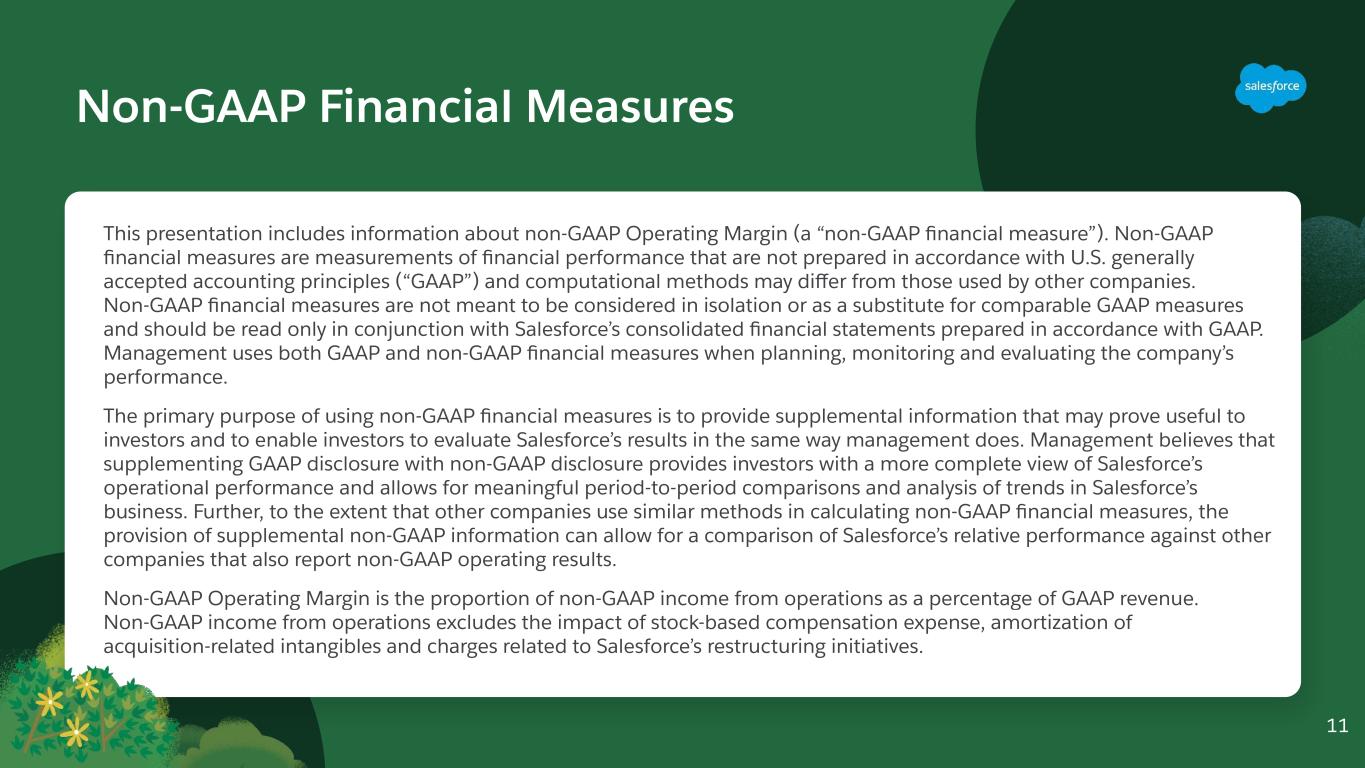
Non-GAAP Financial Measures 11 This presentation includes information about non-GAAP Operating Margin (a “non-GAAP financial measure”). Non-GAAP financial measures are measurements of financial performance that are not prepared in accordance with U.S. generally accepted accounting principles (“GAAP”) and computational methods may differ from those used by other companies. Non-GAAP financial measures are not meant to be considered in isolation or as a substitute for comparable GAAP measures and should be read only in conjunction with Salesforce’s consolidated financial statements prepared in accordance with GAAP. Management uses both GAAP and non-GAAP financial measures when planning, monitoring and evaluating the company’s performance. The primary purpose of using non-GAAP financial measures is to provide supplemental information that may prove useful to investors and to enable investors to evaluate Salesforce’s results in the same way management does. Management believes that supplementing GAAP disclosure with non-GAAP disclosure provides investors with a more complete view of Salesforce’s operational performance and allows for meaningful period-to-period comparisons and analysis of trends in Salesforce’s business. Further, to the extent that other companies use similar methods in calculating non-GAAP financial measures, the provision of supplemental non-GAAP information can allow for a comparison of Salesforce’s relative performance against other companies that also report non-GAAP operating results. Non-GAAP Operating Margin is the proportion of non-GAAP income from operations as a percentage of GAAP revenue. Non-GAAP income from operations excludes the impact of stock-based compensation expense, amortization of acquisition-related intangibles and charges related to Salesforce’s restructuring initiatives.
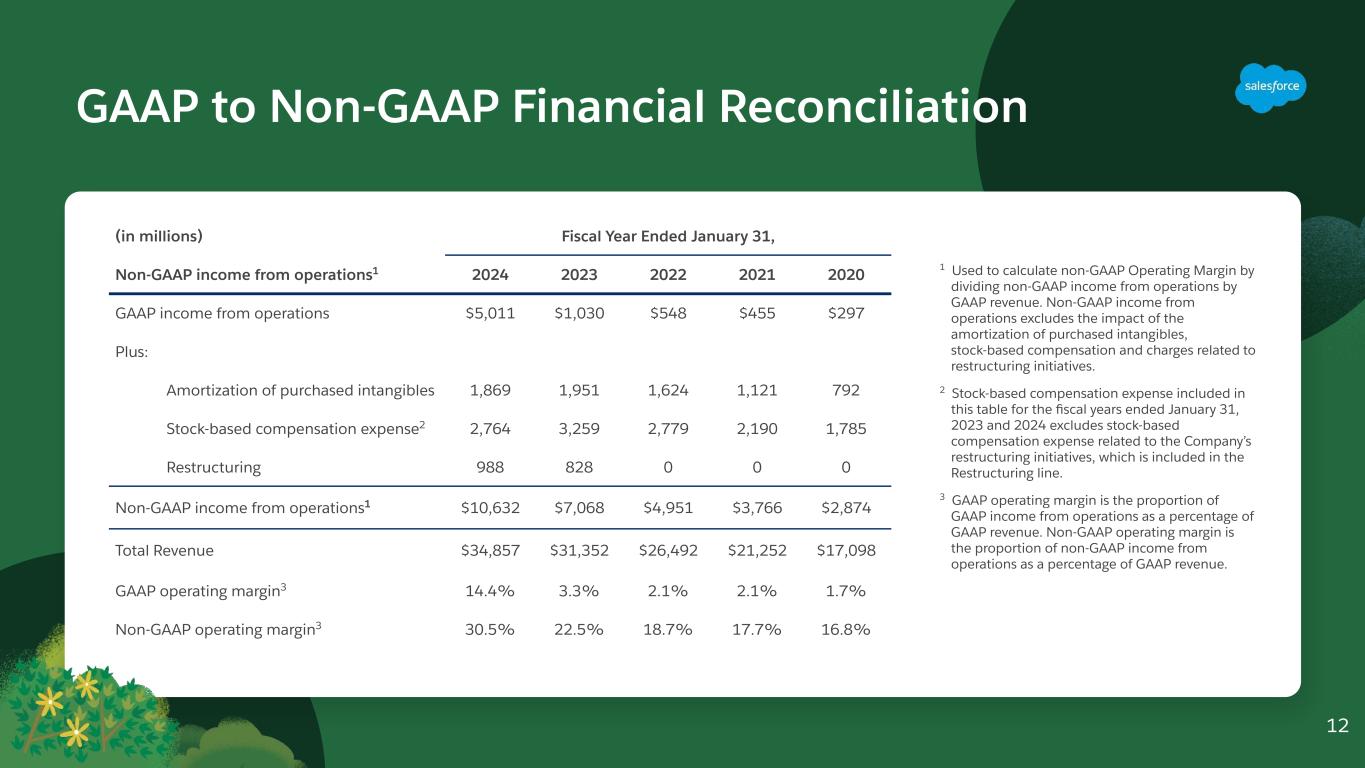
GAAP to Non-GAAP Financial Reconciliation 12 (in millions) Fiscal Year Ended January 31, Non-GAAP income from operations1 2024 2023 2022 2021 2020 GAAP income from operations $5,011 $1,030 $548 $455 $297 Plus: Amortization of purchased intangibles 1,869 1,951 1,624 1,121 792 Stock-based compensation expense2 2,764 3,259 2,779 2,190 1,785 Restructuring 988 828 0 0 0 Non-GAAP income from operations1 $10,632 $7,068 $4,951 $3,766 $2,874 Total Revenue $34,857 $31,352 $26,492 $21,252 $17,098 GAAP operating margin3 14.4% 3.3% 2.1% 2.1% 1.7% Non-GAAP operating margin3 30.5% 22.5% 18.7% 17.7% 16.8% 1 Used to calculate non-GAAP Operating Margin by dividing non-GAAP income from operations by GAAP revenue. Non-GAAP income from operations excludes the impact of the amortization of purchased intangibles, stock-based compensation and charges related to restructuring initiatives. 2 Stock-based compensation expense included in this table for the fiscal years ended January 31, 2023 and 2024 excludes stock-based compensation expense related to the Company’s restructuring initiatives, which is included in the Restructuring line. 3 GAAP operating margin is the proportion of GAAP income from operations as a percentage of GAAP revenue. Non-GAAP operating margin is the proportion of non-GAAP income from operations as a percentage of GAAP revenue.